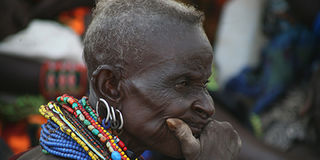Emergency mode as flood death toll rises

An elderly Turkana woman ponders her fate at Lokori in Turkana East District, where three people have been reported dead and an estimated 20,000 displaced after River Kerio, which changed course in 1967, retraced its path following a two-day downpour. Photo/HEZRON NJOROGE
What you need to know:
- Normally dry areas hit hard as torrential rains bring death and destruction
A child was swept away by raging flood waters in Laikipia. Turkana District recorded at least five deaths.
Scores of villages in Turkana West were marooned after the dry valley they settled on when River Kerio changed course in 1967, suddenly retraced its former route.
In Embu and Lodwar, prisoners were left high and dry after torrential rains washed away their buildings.
That was the situation that saw the government yesterday set up a crisis committee as the death toll from floods wreaking havoc in parts of the country rose to 20.
Remedial measures
A meeting of top officials chaired by Vice-President Kalonzo Musyoka was convened to assess the situation and recommend remedial measures as regions which have been dry and arid for years experienced torrential downpours.
The meeting brought together officials from the ministries of Home Affairs, Special Programmes and Provincial Administration.
All district disaster management committees in the affected regions had been reactivated and had been reinforced by officers from the National Disaster Management Committee, said Rift Valley provincial commissioner Osman Warfa on Monday.
Mr Musyoka said the government had stepped up efforts toward providing humanitarian relief to those affected by floods across the country.
The VP regretted that thousands had been displaced by the raging floods and effects of the current rains in many parts of the country, but assured the victims that the government would help them.
He sent out an appeal to donors and well-wishers to step in and boost government efforts to assist those affected. He said the Ministry of Special programmes had already been directed by the President to analyse the destruction caused and the needs for immediate intervention.
“I have spent the better part of today consulting with various agencies over mobilisation of resources to assist those in need,” he said.
According to Kenya Red Cross secretary-general Abass Gullet, the worst affected areas are Turkana East and West, East Pokot, Koibatek, Rongai, Naivasha, Narok, Nyakach and Mogotio districts.
Red Cross estimates that 60,000 people are affected by the floods with 30,000 in dire need of emergency aid.
“I cannot conclusively give the number of deaths though we believe up to 20 people have died in the disaster,” Mr Gullett said in an interview with the Nation. “The situation is desperate and in some places like Turkana East, Mogotio and Rongai, it is dire,” he added.
He said the Red Cross would send relief supplies to the affected regions today, including foodstuff, tents and medical equipment. It is feared that the regions could be hit by a cholera outbreak due to deteriorating sanitary conditions and lack of clean water.
Mr Gullett also said that an unknown number of livestock had been swept away by the floods, denying the owners their source of livelihood.
The Rift Valley PC confirmed that most of the deaths occurred in the Rift Valley.
Turkana Central district recorded the highest number of deaths with five, followed by Rongai and Turkana South with four each and then Turkana East, where three people were killed by raging waters.
Mr Warfa said a child was washed away by floods in Laikipia while a man died in Mogotio after a heavy downpour hit the area on Friday night.
The provincial administrator said 3,700 people had been displaced and 2,955 domestic animals among them camels, donkeys, sheep and goats washed away.
He said that several villages in Turkana East were affected because people had settled on a dry river bed after River Kerio changed its course way back in 1967.
“The river changed its course many years ago and people decided to settle in its way, but unfortunately, it went back to its way after the heavy rains sweeping away homes and livestock,” he said.
He said that the canals in Morulem Irrigation Schemes burst and became rivers following the heavy downpour that has pounded the region since December 23 destroying hundreds of acres of crop.
The PC said the waters causing flash floods in North Rift were flowing from Cherangany Hills.
“There is not much rain in the most affected district; the water is flowing from Cherangany Hills, and we are monitoring the situation there,” he said.
“Relief organisations such as World Vision, Kenya Red Cross and officers from the Ministry of Special Programmes are on the ground helping families move to higher ground and giving the relief food, tents and blankets,” Mr Warfa said.
Additional report by Walter Menya




